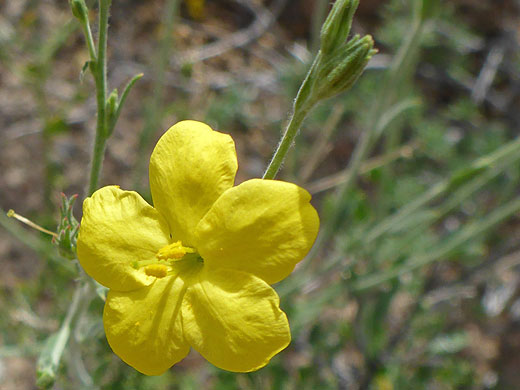
Yellow flower of menodora scabra - on the slopes of Pinkley Peak, Organ Pipe Cactus National Monument, Arizona
Common names:
Rough mendora, menodora scoparia
Family:
Scientific name:
Menodora scabra
Main flower color:
Range:
Mostly in Arizona and New Mexico; also adjacent areas of neighboring states
Height:
Up to 24 inches
Habitat:
Dry hillsides, scrubland, rocky or sandy locations; 1,600 to 7,700 feet
Leaves:
Alternate, lanceolate to linear to oblanceolate, up to one inch long
Season:
April to June
Menodora scabra is a small shrub, no more than 2 feet tall, producing many branched stems, which become woody from the base. Leaves are green, small and numerous; generally oval in shape, widest approximately in the middle, with a prominent, lighter-colored midvein. Stems are angled in cross-section. Younger stems are densely short-hairy, becoming hairless when old. The lowest few pairs of leaves are oppositely arranged; the remainder are alternate.
The inflorescence is a small, terminal cluster. Flowers have a rough-hairy calyx with between five and ten lobes, and five (occasionally six) ovate petals about half an inch across, with rounded tips, angled slightly backwards when fully mature. The two anthers and one stigma are all exserted.
There are two varieties of menodora scabra. The less common var glabrescens are larger plants, with smooth leaves and stems, wider leaves, and 5 to 7 lobed calyces, while the widespread var scabra has rough leaves and stems, narrower, more linear leaves, and calyces with 9 to 10 lobes.
The inflorescence is a small, terminal cluster. Flowers have a rough-hairy calyx with between five and ten lobes, and five (occasionally six) ovate petals about half an inch across, with rounded tips, angled slightly backwards when fully mature. The two anthers and one stigma are all exserted.
There are two varieties of menodora scabra. The less common var glabrescens are larger plants, with smooth leaves and stems, wider leaves, and 5 to 7 lobed calyces, while the widespread var scabra has rough leaves and stems, narrower, more linear leaves, and calyces with 9 to 10 lobes.
All Contents © Copyright The American Southwest | Comments and Questions | Contribute | Site Map


